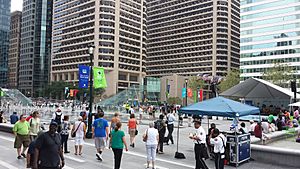Dilworth Park facts for kids
Quick facts for kids Dilworth Park |
|
|---|---|

Dilworth Park with Claes Oldenburg's sculpture Clothespin seen across the street
|
|
| Type | Urban park |
| Location | Philadelphia, Pennsylvania |
| Area | 0.5 acres (0.20 ha) |
| Operated by | Center City District |
| Status | Open all year |
| Public transit access | SEPTA |
Dilworth Park is a lively public park. It's located right next to City Hall in Center City, Philadelphia. This half-acre park first opened its doors to the public on September 4, 2014. It's a popular spot for people of all ages to relax and have fun.
A Look Back: The History of Dilworth Park
Dilworth Park officially opened in September 2014. The park is named after Richardson Dilworth. He was the mayor of Philadelphia from 1956 to 1962. The park you see today was designed by a team of experts. These included KieranTimberlake, Urban Engineers, and OLIN. Before this park, the area was known as Dilworth Plaza. That older plaza was designed by Vincent Kling in 1972.
Centre Square: Philadelphia's Original Plan
City Hall stands in a place once called Centre Square. This Centre Square was one of five main public squares. These squares were planned by William Penn way back in 1682. Penn wanted Centre Square to be the very heart of the city. He imagined important buildings like the Quaker meetinghouse and the state house surrounding it.
For many years, Centre Square didn't become the busy center Penn hoped for. Instead, the areas along the Delaware and Schuylkill rivers became more important. This was because most people lived and worked closer to the rivers. It wasn't until 1871, when construction began on City Hall, that Centre Square truly started to become a central part of Philadelphia.
What Can You Do at Dilworth Park?
Dilworth Park offers many cool features for visitors to enjoy:
- Green grass lawns and pretty plants.
- Two big glass stair covers that let in lots of light.
- A special area that changes! It's a fountain in warmer months and an ice skating rink in winter.
- A cozy cafe where you can grab a snack or a drink.
- A restaurant for a bigger meal.


